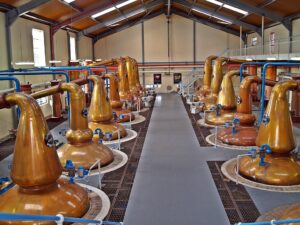The Coppersmith You’ve Never Heard Of Is Also The Oldest
By Richard Thomas

(Credit: Chris McAuley/CC BY-SA 2.0/Wikimedia Commons)
For many whiskey enthusiasts, the beauty of a gleaming copper still takes on a certain romantic allure. That is true whether the enthusiast loves bourbon or Scotch and whether the still is a column or a pot, just so long as it polished. I took to calling photos of these lovely pieces of machinery “copper porn” a long time ago.
Most of those copper-enthralled folks can tell you the names of one or both of the major coppersmiths in the business of making those stills: Vendome in Kentucky and Forsyths in Scotland. Some might know the names of some of the other well-established players in copper still fabrication, like Hoga in Portugal and Spain and CARL in Germany. Beyond these four, the world whisky boom has caused copper fabricators to sprout like mushrooms, especially in the United States.
But one Scottish major still-maker often goes unremarked on, which is especially strange when one considers who they work on: Brora, Caol Ila, Cardhu, Cragganmore, Dalwhinnie, Knockando, Lagavulin and Mortlach, just to name several. Not only does this Scottish coppersmithy work on some of the most esteemed stills in the world, but they are also perhaps the oldest of the major copperworking firms, and certainly the oldest in Scotland. Forsyths opened in 1890 and Vendome in 1910, but this company traces its roots back to 1790.
Their name is Abercrombie, and the reason you’ve probably never heard of them is they have been part of the global drinks giant Diageo for years. Some distilleries whisky companies have in-house coppersmiths as well as in-house coopers; The Balvenie, for example, has a resident coppersmith. Diageo, however, owns 28 malt distilleries plus their grain whisky distillery at Cameronbridge. Their demands are a thing unto themselves, so they acquired Scotland’s most venerable firm to address them.
This doesn’t quite explain why Abercrombie has such a low profile, though. Brown-Forman maintains two cooperages: one in Louisville, plus a new one in Alabama just for Jack Daniel’s. That Brown-Forman makes their own barrels hardly keeps these facilities on the down-low, far from it. Nevertheless, because no one spoke of Abercrombie in the same way that they revere Forsyths, I remained unaware of their existence for years, with the first peep in the media about them being in 2015 when they marked 50 years at their present Alloa location, and again in 2017 when Abercrombie hired its the first female apprentice.
The way Diageo does business leaves most observers scratching their heads. Abercrombie got some mentions when the conglomerate announced it was going to reopen the legendary Brora Distillery, because the coppersmiths would obviously be doing the work in rehabilitating the plant’s signature equipment. But when Diageo decided to get back into Irish whiskey with Roe & Co., mum was the word about Abercrombie building the triple set of stills going to Dublin. This despite the obvious fact that, being based in Dublin, thousands of tourists would potentially see them every year. The only photos of Roe & Co.’s equipment as it was being made that I could find were from a blog on Prohibition University. When I searched the Diageo corporate website for this article, “Abercrombie” scored just two hits, and one of those was irrelevant.
So, I suppose it follows that Diageo doesn’t use the romance of the copper and the people who work it to the extent that an independent firm, like Forsyths, would. Abercrombie no longer needs to advertise its work, and it is easy to imagine that Diageo views them as something like a department of engineering or maintenance (albeit a highly specialized department), not as something to incorporate into their marketing and storytelling. The latter is a dreadful oversight, of course. As any true whisky fan can tell you: copper is romantic.



